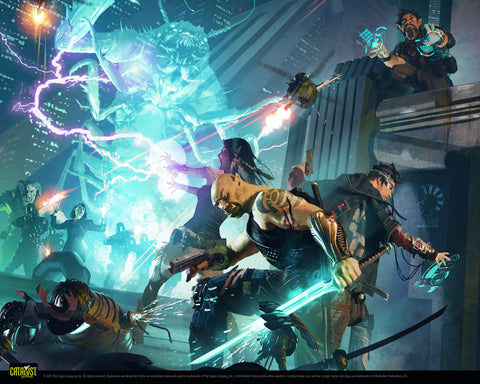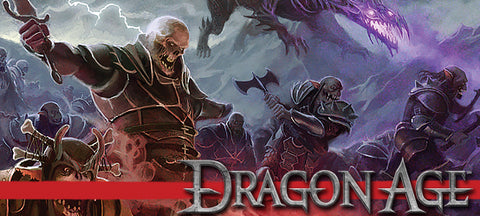
Roll the Dice: D10 and D6 Gaming Systems
Greetings Adventurers!
July 2nd, 2020 – As players, we all know dice can be our best friend or our greatest enemy. They are one of the most important tools in most tabletop RPGs, as dice rolls help determine what happens during the collaborative storytelling experience.
Gaming Systems

Source: Ian Gonzalez on Unsplash
As the King of tabletop RPGs, Dungeons and Dragons uses a d20 system where players roll a 20-sided die to resolve an action and add modifiers based on their character proficiencies (determined by Strength, Dexterity, Constitution, Intelligence, Wisdom, and Charisma) and other skills the character is adept in, such as combat, magic, religion, athletics and so on.
If the result is greater than or equal to a target number known as a Difficulty Class (DC) then the action succeeds. While other dice do come into play during D&D, the d20 is the single most used die throughout the game.
The d20 system is one of the most popular methods used in many games and is a system most players are familiar with. But did you know some games utilize a whole different dice system than the common d20?

Source: Dakota Irish
We recently added listings for random 10d10 and 6d6 in our store for players who enjoy playing TTRPG’s that use d10 and d6 playing systems. You might be wondering, what games use d10 and d6 systems? Well, you are in luck! Here is a list of some games for you to check out:
D6 Systems
In a d6 system, players roll a single 6-sided dice, if the roll is equal to or higher than the difficulty class, the player will succeed.
Shadowrun

Source: ShadowrunTabletop
Shadowrun is a science fantasy tabletop role-playing game set in a near-future fictional universe in which cybernetics, magic and fantasy creatures co-exist. It combines genres of cyberpunk, urban fantasy and crime, with occasional elements of conspiracy, horror and detective fiction. From its inception in 1989, Shadowrun has remained among the most popular role-playing games. It has spawned a vast franchise that includes a series of novels, a collectable card game, two miniature-based tabletop wargames, and multiple video games.
GUMSHOE

Source: PelgranePress
GUMSHOE is a system for designing and playing investigative roleplaying games and adventures, emulating stories where investigators uncover a series of clues and interpret them to solve a mystery.
In a GUMSHOE game, the player characters discover something which triggers their investigation, and then the Game Moderator (GM) narrates them through a number of scenes, during which they use their Investigative Abilities to gather the core clues they need to move the narrative forward. They must then put the clues together to uncover the secrets behind the mystery.
Games that use the GUMSHOE play system include:
- Ashen Stars
- The Esoterrorists
- Fall of Delta Green
- Fear Itself
- The Gaean Reach
- Lorefinder
- Mutant City Blues
Dragon Age RPG

Source: Bell of Lost Souls
Dragon Age is a role-playing game published by Green Ronin Publishing in 2010. It is based on the Dragon Age video game series by BioWare and uses the video game series' setting.
The game uses traditional tabletop role-playing game features, such as character classes (fighter, mage and rogue), races (human, dwarf or elf), and ability scores. Gameplay in the system centres around the use of three six-sided dice for all rolls. One die called the "dragon die", is differently coloured than the other two. When doubles appear on any roll, the player can perform special actions called "stunts", based on the value on the dragon die.
Kobolds Ate My Baby!!!

Source: Alchetron
Kobolds Ate My Baby! (also known as KAMB) is an independently published role-playing game from 9th Level Games, a small-press publisher and designer of humorous role-playing games (RPGs) based in Pennsylvania.
Players assume the roles of Kobolds, creatures who are often used as weak but numerous "cannon fodder" characters in fantasy role-playing games such as Dungeons & Dragons. KAMB supposedly refutes this role, while at the same time playing up this and other stereotypes of fantasy role-playing.
The game takes a generally humorous look at the genre and encourages joking and ludicrous, boisterous behaviour among the players, the chief of which is the rule that whenever the name of the kobolds' King, Torg (All Hail King Torg!), is mentioned, all present are required to loudly proclaim, "ALL HAIL KING TORG!
Kobolds Ate My Baby! combines ridiculously over the top humour with a quick and easy to learn game system - sure to delight both veteran and newbie gamers alike.
D10 Systems
In a d10 system, a 10-sided die is rolled to determine if actions are successful. Players will add up modifiers, such as skill and equipment, to determine how many dice are rolled. The more dice rolled, the higher chance of success.
Call of Cthulhu

Source: Ultra Board Games
Call of Cthulhu is a horror fiction role-playing game based on H. P. Lovecraft's story of the same name. The game was first published by 1981 by Chaosium. It makes use of Chaosium's Basic Role-Playing (BRP) system, with special rules for Sanity.
The game’s plots are designed to challenge the investigators. Each adventure is different, but your investigator is always at risk of becoming injured, suffering sanity-shattering experiences, or even be eaten by a monster!
As the game progresses, investigators can gain secret knowledge from arcane books about the monsters and dark forces of the Cthulhu Mythos, as well as advancement in their skills as they become more experienced.
One player takes on the role of the Keeper, who chooses a scenario or creates their own story. The Keeper describes the scenes of the story, portrays the people whom the investigators meet, an impartially governs the game’s rules.
The game is an evolving interaction between players - in the guise of their characters unravelling a mystery - and the Keeper, who presents the world in which the stories take place.
The purpose of roleplaying is to have fun. Right down to pounding hearts and sweating brows, it's part of human nature to find pleasure in being scared, as long as being scared is not for real. Call of Cthulhu features engaging mysteries, scares, and laughs too – it’s the fun of being challenged and finding solutions while also encountering horrors from beyond space and time!
Vampire: The Masquerade

Source: The Gamer
Vampire: The Masquerade is a tabletop role-playing game created by Mark Rein-Hagen and released in 1991 by White Wolf Publishing as the first of several Storyteller System games for its World of Darkness setting line.
Set in a fictionalized "gothic-punk" version of the modern world, players assume the role of vampires, who are referred to as "Kindred", immortal beings cursed with an unquenchable thirst for blood and vulnerability to sunlight – creatures forever bound to their inner Beast (the animal urges of hunger, fear and rage).
It is a game of personal horror, where the characters deal with their night-to-night struggles against their own bestial natures, vampire hunters and each other and are forced to walk a moral tightrope between their need to survive and the horrific means by which they ensure it.
Buffy the Vampire Slayer
Sticking with the vampire theme, based on the world and the characters of the hit late 90’s television series. The Buffy the Vampire Slayer RPG was published by Eden Studios, Inc in 2002.
In the game, players are able to take on the roles of characters from the hit television series or create their own original characters effectively building their own Buffyverse series in the process.
Players help tell a fully interactive story guided by a Director, who works very hard to give them all something to reduce to a pile of dust. The Director sets up a story treatment, casts the bad guys and innocent victims, and keeps everything pointed plotward.
The game uses a sleek, accessible ruleset known as the "Drama Points" system, which gives players a greater degree of control over the flow of the story, allowing them to call upon heroic bursts of energy, plot twists, and other convenient developments as necessary.
With the Buffy the Vampire Slayer RPG, you can play one-night stands against demons, or go the whole semester with Buffy, Willow, Xander and the rest in a series of interconnected adventures.
Rolemaster

Source: Ironcrown
Rolemaster offers advanced and expert role players the opportunity to take part in a game filled with gritty realism and exciting open-ended dice roles where the only limit is your imagination.
Rolemaster is a very detailed, consistent and intuitive role-playing game designed for those who want more out of their gaming experience. It is an extremely customizable skill-based system where character development is truly in the hands of the player as every skill is available to every player while making use of professions to determine the development cost for the skill. This makes every character unique and allows the system to be used with any setting.
While Rolemaster offers far more roleplaying than just combat, the combat system is often considered one of the best aspects of the game. The critical charts make combat far more realistic and exciting.
It does away with the idea of combat damage as simple numbers and replaces it with life-threatening strikes. Combat has moved from a basic dice-rolling mechanic to a strategic decision, as the players are now forced to consider how aggressive they wish to be, and thereby how much they leave themselves open to a death-dealing critical.

Source: Giphy
These are just some examples of games that use d10 or d6 systems. There are so many more games that use different styles of TTRPG systems out there for you to try! Have you played any games that use different playing system? Let us know in the comments.
Until next time players!

